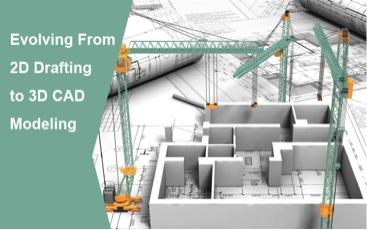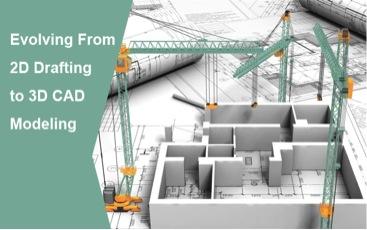What Does It Take to Evolve from 2D to 3D CAD Modeling?
April 23, 2015

Despite the astronomical benefits offered by 3D modeling, it is quite surprising that nearly 75% of the manufacturing industries still perform design operations using 2D CAD systems.
What is the reason that keeps companies hesitant from adopting 3D technology?
Knowing the amount of benefits 3D modeling offers, why is it taking so long for manufacturers to evolve from conventional 2D CAD drafting to faster, better 3D modeling? Is it too costly or time-consuming to implement this change? Or, are these perceptions simply because of knowledge inadequacy amongst manufacturers?
In today's competitive market, engineers and designers are strained to develop new designs that sell and can be manufactured faster. In such a disruptive market scenario, 2D drafting can consume valuable time in product development. 3D modeling is the only way ahead, helping in speeding up design thinking, encouraging designers to innovate, and spotting errors as soon as they occur.

Why do manufacturers still use 2D?
Some of the prominent reasons why manufacturers are stuck with conventional 2D systems are partly because the advantages with 3D modeling are not well understood and partly because they are not ready to accept it. Some manufacturers prefer to stick with 2D tools mainly because a large volume of design information was prepared in 2D; converting all those drawings in 3D would be time-consuming and affect their production.
Many even cite that their end customers demand 2D deliverables, making it necessary to stick to conventional drafting technology. It is also believed that the amount of time and cost required to train the resources for 3D technology would unnecessarily add additional cost in product development. This has led manufacturers to be rigid toward adopting 3D and do not want to lose their 2D skills developed over many years.
Advantages of 3D modeling
2D drawings are indeed important for many of the industrial domains such as electrical and architectural. But they are not ideal for representing the product features to customers or supply vendors. Moreover, there is a possibility of misinterpretation and ambiguity, which can lead to errors and loss in time to implement last-moment design changes.
MORE FROM DESIGN NEWS: 3D Simulation Goes Mainstream
With 3D, engineers can produce geometrically accurate and digital product models, which can be utilized throughout the manufacturing process, right from product development to final assembly. Along with the use of collaboration tools, these models can be reviewed and modified collaboratively using the feedback from customers, subcontractors, and suppliers. This results in better and faster product development. These features don't necessarily reduce the importance of 2D drawings.
3D CAD systems tightly integrate 2D tools, on the basis of which 3D models are developed. With the ability to detect interference between parts, mechanism motion, and assembly structure, designing in 3D is extremely faster, promoting innovation and creativity through advanced and powerful modeling tools.
Shifting from 2D to 3D
For individuals unfamiliar with 3D systems, the only possible way to comprehensively shift the entire design process from 2D to 3D can only be performed by first seeing and trying it out. It is not possible to rely on elementary information that software provides to exploit the powerful 3D tools.
Although, a new user will have enough supportive material to begin a design with, the tools are required to be learned comprehensively. The training program should have a "learn as you go" strategy and figure out the potential of each command or tool progressively.
MORE FROM DESIGN NEWS: Seamless 3D Simulation - Blending Big Data into CAD
CAD software providers have realized the problems with the transition, and it is the only reason why hybrid 2D/3D technology has emerged significantly. The hybrid approach involves complete 2D integration within the 3D modeling system, and users have the option to work under different design modes progressively, rather than going for full-fledged 3D designing. It fulfills the requirement for vendors and contractors that demand 2D drawings, while aiding designers in working on complex product assemblies. This step-by-step transition can help manufacturers in evolving from their traditional 2D practices to faster, better, and cost-effective 3D modeling.
There is also a number of outsourcing consultants that provide 2D to 3D migration services along with their support to convert existing 2D drawings to 3D. Utilizing these services can be a cost-effective strategy, as well, as it helps in converting all the old design information into 3D models, which can be further utilized to produce new product designs or implement modifications in existing ones.
Gaurang Trivedi is an engineering consultant at TrueCADD. TrueCADD. Besides donning multiple hats as a website manager and marketer in charge, he also oversees TrueCADD's editorial content, coordinating and managing the website, its news sections, blogs, and social media promotions.
Design engineers, New England's premier design and manufacturing event, Design & Manufacturing New England, will take place in Boston, May 6-7, 2015. A Design News event, Design & Manufacturing New England is your chance to meet qualified suppliers, get hands-on with the latest technologies, be informed, and expand your network. Learn more here.
About the Author(s)
You May Also Like





